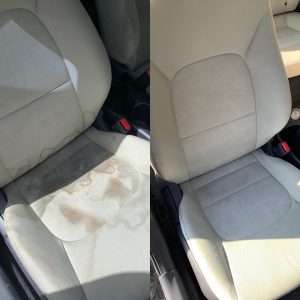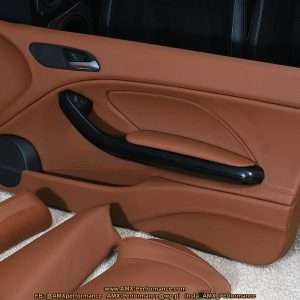Understanding Leather Care
Leather car interiors require special care to maintain their beauty and prevent damage. Regular cleaning and conditioning are essential. It’s a good idea to clean your leather seats at least every few months. This prevents dirt and grime from building up.
Different types of leather require different cleaning methods. Always test a small, inconspicuous area first. This will ensure the cleaner doesn’t damage the leather.
Gathering Your Supplies
Before you begin, gather the necessary supplies. This will make the cleaning process more efficient. Here’s what you’ll need:
- Soft microfiber cloths
- A vacuum cleaner with a soft brush attachment
- Leather cleaner (or a homemade solution)
- Leather conditioner
- Warm water
- Two buckets
Having everything ready will save you time and effort. It is very important to use soft cloths to avoid scratching the leather.
Homemade Leather Cleaner
You can create a gentle and effective leather cleaner using household ingredients. A simple solution of mild soap and water works well; Be sure to use distilled water to avoid mineral deposits.
Here’s a recipe:
- 1/4 cup mild liquid soap (like baby shampoo)
- 1 quart of warm distilled water
Mix the soap and water in a bucket. Dip a microfiber cloth into the solution, wring it out well, and gently wipe the leather surfaces. Avoid soaking the leather.
Cleaning the Leather
Start by vacuuming the leather surfaces to remove loose dirt and debris. Use the soft brush attachment to avoid scratching the leather. Pay attention to seams and crevices where dirt tends to accumulate.
Next, dampen a microfiber cloth with your chosen cleaner (homemade or commercial). Gently wipe the leather surfaces in a circular motion. Avoid applying too much pressure. Work in small sections to prevent the cleaner from drying on the leather.
After cleaning, wipe the leather with a clean, damp cloth to remove any soap residue. Allow the leather to air dry completely before applying conditioner.
Conditioning the Leather
Conditioning is crucial for maintaining the suppleness and preventing cracking. Leather conditioner replenishes the natural oils that are lost during cleaning. Apply a small amount of leather conditioner to a clean microfiber cloth.
Gently massage the conditioner into the leather in a circular motion. Allow the conditioner to absorb for at least 15-20 minutes. Wipe off any excess conditioner with a clean, dry cloth.
Regular conditioning will keep your leather looking its best. It will also extend its lifespan.
FAQ: Leather Car Interior Cleaning
How often should I clean my leather car seats?
Ideally, you should clean your leather car seats every 1-3 months. This depends on how often you use your car and the conditions it’s exposed to. Regular cleaning prevents dirt buildup and keeps the leather looking its best.
Can I use baby wipes to clean leather car seats?
While baby wipes might seem convenient, they’re not ideal for cleaning leather. They can contain chemicals that may dry out or damage the leather over time. It’s best to use a dedicated leather cleaner or a mild soap and water solution.
What should I do if I spill something on my leather seats?
Act quickly! Blot the spill immediately with a clean, dry cloth. Avoid rubbing, as this can spread the stain. Then, clean the area with a leather cleaner and condition it afterward.
Leather car interiors require special care to maintain their beauty and prevent damage. Regular cleaning and conditioning are essential. I’ve found that cleaning my leather seats at least every few months is a good rule of thumb. This prevents dirt and grime from building up.
Different types of leather require different cleaning methods. I always test a small, inconspicuous area first. Trust me, I learned this the hard way once with a cleaner that slightly discolored a seat! Now, I’m extra cautious.
Before you begin, gather the necessary supplies. This will make the cleaning process more efficient. Here’s what I usually have on hand:
- Soft microfiber cloths ─ I buy a big pack of these!
- A vacuum cleaner with a soft brush attachment ─ essential for getting into those crevices.
- Leather cleaner (or a homemade solution) ー I’ve tried both, and both work well.
- Leather conditioner ー Don’t skip this step!
- Warm water
- Two buckets ─ one for cleaning solution, one for rinsing.
Having everything ready really saves me time and effort. And believe me, it is very important to use soft cloths to avoid scratching the leather. I learned that lesson early on!
You can create a gentle and effective leather cleaner using household ingredients. A simple solution of mild soap and water works well. I always use distilled water to avoid mineral deposits. Tap water left a slight residue once, and I didn’t like that.
Here’s a recipe I’ve used successfully:
- 1/4 cup mild liquid soap (like baby shampoo) ー I use the unscented kind.
- 1 quart of warm distilled water
I mix the soap and water in a bucket. Then, I dip a microfiber cloth into the solution, wring it out really well, and gently wipe the leather surfaces. I avoid soaking the leather at all costs.
I always start by vacuuming the leather surfaces to remove loose dirt and debris. I use the soft brush attachment to avoid scratching the leather. I pay special attention to seams and crevices where dirt tends to accumulate. Those areas can get really gross!
Next, I dampen a microfiber cloth with my chosen cleaner (homemade or commercial). I gently wipe the leather surfaces in a circular motion. I avoid applying too much pressure. I work in small sections to prevent the cleaner from drying on the leather. That’s key!
After cleaning, I wipe the leather with a clean, damp cloth to remove any soap residue. Then, I allow the leather to air dry completely before applying conditioner. Patience is key here.
Conditioning is crucial for maintaining the suppleness and preventing cracking. Leather conditioner replenishes the natural oils that are lost during cleaning. I apply a small amount of leather conditioner to a clean microfiber cloth.
I gently massage the conditioner into the leather in a circular motion. I allow the conditioner to absorb for at least 15-20 minutes. Then, I wipe off any excess conditioner with a clean, dry cloth. If I don’t wipe it off, it can feel a little sticky.
Regular conditioning will keep your leather looking its best. It will also extend its lifespan. I’ve been doing this for years, and my leather seats still look almost new!
In my experience, you should clean your leather car seats every 1-3 months. This depends on how often you use your car and the conditions it’s exposed to. Regular cleaning prevents dirt buildup and keeps the leather looking its best. I clean mine more often in the summer because I’m always at the beach!
While baby wipes might seem convenient, I don’t recommend them for cleaning leather. They can contain chemicals that may dry out or damage the leather over time. It’s best to use a dedicated leather cleaner or a mild soap and water solution. I tried it once, and the seats felt a little stiff afterward.
Act quickly! I learned this the hard way when I spilled coffee all over my passenger seat. Blot the spill immediately with a clean, dry cloth. Avoid rubbing, as this can spread the stain. Then, clean the area with a leather cleaner and condition it afterward. I had to clean that coffee stain twice to get it completely out!
Dealing with Stubborn Stains
Sometimes, you’ll encounter stubborn stains that are difficult to remove with regular cleaning. I had a pen mark on my seat once that wouldn’t budge! For these situations, I’ve found that a specialized leather stain remover can be helpful.
Before using any stain remover, read the instructions carefully and test it on a hidden area. Apply the stain remover to a clean cloth and gently blot the stain. Avoid rubbing vigorously, as this can damage the leather. After removing the stain, clean and condition the area as usual.
I used a leather stain remover on that pen mark, and it came right out! I was so relieved.
Protecting Your Leather
Once your leather is clean and conditioned, consider applying a leather protectant. This will help to shield the leather from UV rays, spills, and other potential damage. I use a leather protectant spray every few months to keep my seats looking their best.
Apply the protectant according to the manufacturer’s instructions. Usually, this involves spraying a thin, even coat onto the leather and allowing it to dry completely. A leather protectant can really extend the life of your leather interior.
I’ve noticed a big difference since I started using a leather protectant. My seats are much more resistant to stains and fading.




